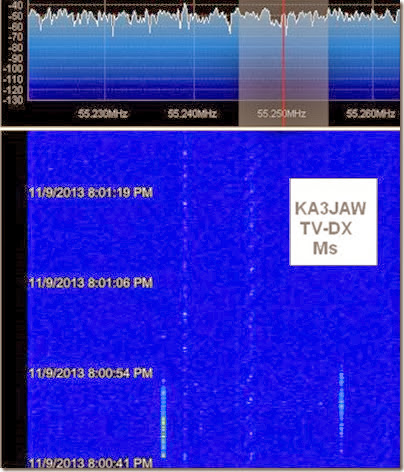
By Mike Schaffer, KA3JAW (fn20iq)
This is a follow-up to the October 4, 2013 article titled $20 Multimode Software Defined Radio.
On October 26, 2013 at 22:47 UTC (6:47 pm EDT), a negative 4.00 stellar magnitude meteor (less than a category negative 4.50 magnitude fireball) from the Orionids meteor shower caused by small fragments of comic debris from Halley's Comet streaked between the boroughs of Mountain Top and Freeland, then over Kunkletown, reaching into the Lehigh Valley in Pennsylvania.
Seconds later, its light yellow flame was seen overhead in Nazareth, then the Delaware River and finally making its way to Marble Hill, New Jersey, while blazing at a velocity of 41 miles per second (67 km/sec).
It was determined the meteor tracked 3.7 miles north of Center Square in Easton, PA.
Closest approach was 3.0 miles to the northeast when it fragmented into smaller pieces while cruising at a 45 degree inclination during its 3.5-second flight journey through Earth's atmosphere.
The Orionids meteor shower was active from October 4 to November 14, 2013. Peak nights occurred on October 21-22. Meteor rates were expected to be 50 to 75 per hour.
At the time of event on October 26, I was home in south Easton with two NTSC analog television sets turned to channel 2 with the volume set at a comfortable listening level waiting for a chance of TV-DX via Sporadic E or F2 propagation. Unfortunately neither occurred.
Something very rare did occur at 6:15 pm EDT, exactly 32 minutes prior to the meteor event stated above overhead near Easton, while hoping to catch the Canadian network CTV, call sign CKCO in Wiarton, Ontario via meteor scatter (Ms) on 55.240 MHz (minus offset) at a distance of 941 miles. Without warning the TV's audio steady background noise rapidly flared producing what sounds similar to a burst of high pressure air leaking through a cracked pipe. That effect instantly startled me for about three seconds.
Later, I realized that sound effect was not the result of a meteor forward scatter mode, but rather the ionized atmospheric gases (plasma) surrounding the meteor while leaving a vapor trail overhead. It seemed as if the meteor was exiting through the TV tube! After nine years of TV-DXing I never experienced this phenomenon!
It was this rare event that inspired me to take a more active roll in finding other techniques in meteor detection --- using the $20 STL-SDR dongle. After some experimentation, I can confirm that this inexpensive device has enough sensitivity to detect, spot and track meteors.
I would like to share snapshot images of what a meteor looks like on the SDR# (SDR Sharp) waterfall display.

The above snapshot shows the STL-SDR device tuned (red dial line) to a frequency of 55.250 MHz. On both sides of this frequency (55.240 and 55.260 MHz) you can see two vertical meteor scatter traces starting at the date/time stamp displayed at the left margin. The first trace (on 55.240) is a moderate signal strength signal from CKCO in Wiarton, Ontario, over 421 air miles distance. The second trace is a weak signal strength signal on 55.260 from CIII in Bancroft, Ontario over 320 air miles distance. More sample images can be found here on Photobucket
To detect meteors via forward scatter propagation there has to be powerful (25 kW or more)radio frequency transmitter at one end point that is on the air 24 hours a day, such as a
full-power TV facility that radiates 100 kW on their video carrier with 10 kW audio. In my technique, I am not concerned with the audio portion of the signal.
The above statement would meet half of our requirements. The US TV broadcast conversion from analog to digital went into effect on June 12, 2009, per Congressional mandate. Unknown to many citizens, there are analog US TV signals on the air since the DTV transition (currently 72 low-powered analog TV stations are on the air in the US). These stations are Class-A , low-powered translators that run from 2 watts up to 3 kW on channel 2. Again, the power is not strong enough for Ms detection.
By now you may be wondering how will we be able to find any full-power 100 kW broadcasters in which to do TV-DX via meteor scatter using the STL-SDR dongle. There is one other option to peruse. Our maple leaf friends up along the Canadian/US border have five analog TV-2 channels that remain active since their DTV analog-to-digital transition went into effect on August 31, 2011. This option has an extra advantage as there will be no US-based high-powered NTSC analog television stations to cause any radio frequency interference issues.
By the way, normal meteor scatter range is up to 1,400 miles.
Good DX!
 CQ Communications, Inc. announced today that "Effective with the February 2014 issue of CQ, content from the magazine's three sister publications, Popular Communications, CQ VHF and WorldRadio Online, will be incorporated into CQ's digital edition as a supplement to be called 'CQ Plus.'"
CQ Communications, Inc. announced today that "Effective with the February 2014 issue of CQ, content from the magazine's three sister publications, Popular Communications, CQ VHF and WorldRadio Online, will be incorporated into CQ's digital edition as a supplement to be called 'CQ Plus.'"






